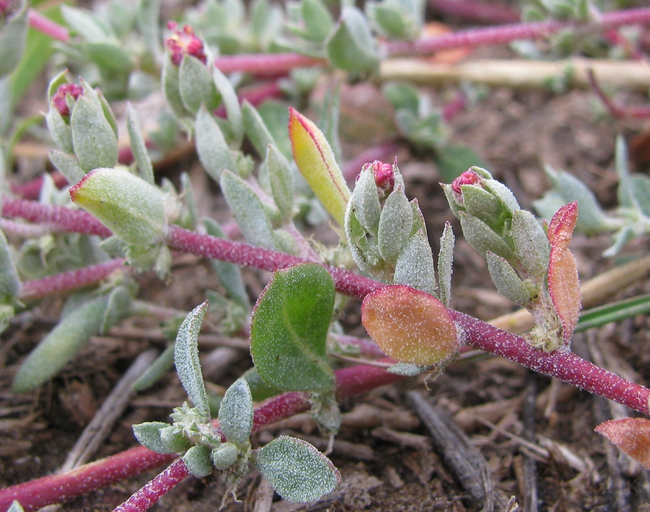
Coulter's Saltbush
Atriplex coulteri
Atriplex coulteri
Photo Credit: copyright Andrew Borcher (2009)
| Historically present | |
| Between 2000 and | |
| Last 10 years |
Goal: Maintain, enhance and restore alkali playa vegetation communities on Conserved Lands in the MSPA that supports or has the potential to support VF species (i.e., Coulter's saltbush, Parish's brittlescale, southern tarplant) so that the vegetation community has high ecological integrity, and these species are resilient to environmental stochasticity, catastrophic disturbances and threats, such as very large wildfires, invasive plants and prolonged drought, and will be likely to persist over the long term (>100 years).
Management units: 3, 5
In 2018, inspect occurrences of alkali playa MSP VF plant species (i.e., Coulter's saltbush, Parish's brittlescale, southern tarplant) on Conserved Lands using the regional IMG monitoring protocol to record abundance and collect habitat and threat covariate data to determine management needs.
| Action | Statement | Action status | Projects |
|---|---|---|---|
| IMP-1 | Based upon occurrence status and threats, determine management needs including whether routine management or more intensive management is warranted. | on hold | |
| IMP-2 | Submit project metadata, monitoring datasets and management recommendations to the MSP Web Portal. | on hold |
| Criteria | Deadline year |
|---|---|
| Surveys Completed 2018 with Management Recommendations | 2021 |
| Threat Name | Threat Code |
|---|---|
| Altered hydrology | ALTHYD |
| Human uses of the Preserves | HUMUSE |
| Invasive plants | INVPLA |
| Urban development | URBDEV |
| File name | Lead Author | Year | Type |
|---|---|---|---|
| MSP Roadmap Dec 31, 2016: VF Species and Vegetation Goals, Objectives, and Actions | San Diego Management and Monitoring Program | 2016 | other |
From San Luis Obispo to Baja California, Mexico, including 6 of the 8 Channel Islands (not found on Santa Barbara or San Nicholas islands) [1].
Historically, quite rare in San Diego [2].
None [1].
Elevation 3-460 m (10-1509 ft) [1]. Associated with clay or alkaline soils supporting grasslands, coastal sage scrub, bluff scrubs, or coastal dune vegetation [1].
Some herbarium specimens need to be differentiated from Atriplex pacifica, and further taxonomic work is needed to clearly delineate the two species [2]. Coulter’s saltbush has a more pronounced and serrated fruiting bract that Pacific saltbush [2].
Perennial herb in the Chenopodiaceae family [1].
Blooming period March to October [1].
Threatened by development in the thin microhabitat at the edge of sea bluffs where species of saltbush thrive [2]. Possibly threatened by feral herbivores [1].
Species may be nearing extirpation from mainland California [2]. All mainland populations should be protected with adequate buffers.
[1] CNPS, Rare Plant Program. 2016. Inventory of Rare and Endangered Plants (online edition, v8-02). California Native Plant Society, Sacramento, CA. http://www.rareplants.cnps.org, accessed 25
[2] Reiser, C.H. 2001. Rare Plants of San Diego County. Aquafir Press, Imperial Beach, CA.